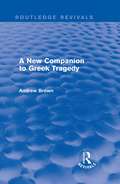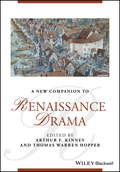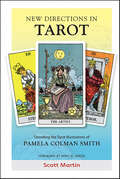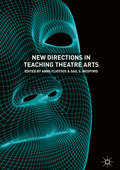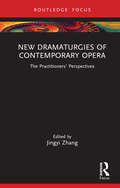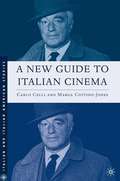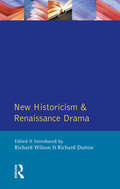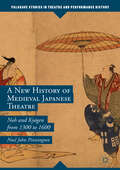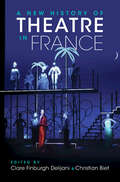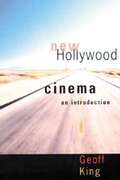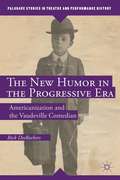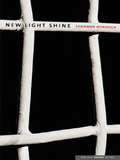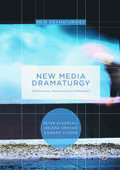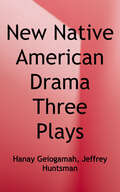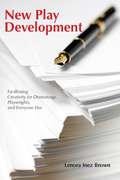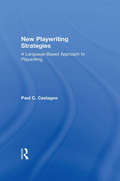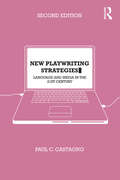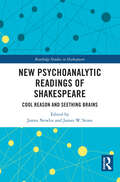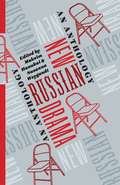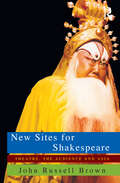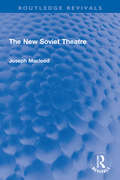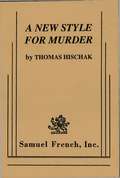- Table View
- List View
A New Companion to Greek Tragedy (Routledge Revivals)
by Andrew BrownThat the works of the ancient tragedians still have an immediate and profound appeal surely needs no demonstration, yet the modern reader continually stumbles across concepts which are difficult to interpret or relate to – moral pollution, the authority of oracles, classical ideas of geography – as well as the names of unfamiliar legendary and mythological figures. A New Companion to Greek Tragedy provides a useful reference tool for the ‘Greekless’ reader: arranged on a strictly encyclopaedic pattern, with headings for all proper names occurring in the twelve most frequently read tragedies, it contains brief but adequately detailed essays on moral, religious and philosophical terms, as well as mythical genealogies where important. There are in addition entries on Greek theatre, technical terms and on other writers from Aristotle to Freud, whilst the essay by P. E. Easterling traces some connections between the ideas found in the tragedians and earlier Greek thought.
A New Companion to Renaissance Drama (Blackwell Companions to Literature and Culture)
by Arthur F. Kinney Thomas Warren HopperA New Companion to Renaissance Drama provides an invaluable summary of past and present scholarship surrounding the most popular and influential literary form of its time. Original interpretations from leading scholars set the scene for important paths of future inquiry. A colorful, comprehensive and interdisciplinary overview of the material conditions of Renaissance plays, England's most important dramatic period Contributors are both established and emerging scholars, with many leading international figures in the discipline Offers a unique approach by organizing the chapters by cultural context, theatre history, genre studies, theoretical applications, and material studies Chapters address newest departures and future directions for Renaissance drama scholarship Arthur Kinney is a world-renowned figure in the field
New Directions: Ways of Advance for the Amateur Theatre (Routledge Revivals)
by Peter Burton David LaneNew Directions (1970) is a handbook for amateur dramatists packed with ideas and practical advice on production, choosing plays, improvisation, make-up, costumes, street drama, scenery and documentaries. The authors offer choices of solutions to problems, and suggest ways to experiment and improvise.
New Directions in Tarot: Decoding the Tarot Illustrations of Pamela Colman Smith
by Scott MartinA look at how Pamela Colman Smith's theatrical knowledge and experience came into play when she drew the iconic cards of the Rider-Waite-Smith deck. The &“secrets&” in this book have been known all along, and they work in all who read Tarot on a subconscious level. This insightful book delves deeply into the images Pamela Colman Smith created for the Rider-Waite-Smith Tarot, and reminds us of what we may have known intuitively but had not been aware of on a conscious level. • A brand-new approach that focuses on how, in her images, Smith utilized a sense of direction, body movement, posture, gait, facial expression, and more • Compares the Tarot Minors to technical elements of theater, including plot, conflict, elements of a play, thought/theme, dialogue, music, and actors&’ positions on stage • Provides powerful tools for interpreting the cards and discovering new meanings that the reader can make their own • Includes thought-provoking exercises that guide the reader in the mastery of these new insights The result is a fresh take on Tarot that brings new meanings to light and enables the reader to evaluate what the Tarot provides like never before.
New Directions in Teaching Theatre Arts
by Anne Fliotsos Gail S. MedfordThis book reflects the changes in technology and educational trends (cross-disciplinary learning, entrepreneurship, first-year learning programs, critical writing requirements, course assessment, among others) that have pushed theatre educators to innovate, question, and experiment with new teaching strategies. The text focuses upon a firm practice-based approach that also reflects research in the field, offering innovative and proven methods that theatre educators may use to actively engage students and encourage student success. The sixteen essays in this volume are divided into five sections: Teaching with Digital Technology, Teaching in Response to Educational Trends, Teaching New Directions in Performance, Teaching Beyond the Traditional, and Teaching Collaboratively or Across Disciplines. Study of this book will provoke readers to question both teaching methods and curricula as they consider the ever-shifting arts landscape and the potential careers for theatre graduates.
New Dramaturgies: Strategies and Exercises for 21st Century Playwriting (Focus on Dramaturgy)
by Mark BlyIn New Dramaturgies: Strategies and Exercises for 21st Century Playwriting, Mark Bly offers a new playwriting book with nine unique play-generating exercises. These exercises offer dramaturgical strategies and tools for confronting and overcoming obstacles that all playwrights face. Each of the chapters features lively commentary and participation from Bly’s former students. They are now acclaimed writers and producers for media such as House of Cards, Weeds, Friday Night Lights, Warrior, and The Affair, and their plays appear onstage in major venues such as the Roundabout Theatre, Yale Rep, and the Royal National Theatre. They share thoughts about their original response to an exercise and why it continues to have a major impact on their writing and mentoring today. Each chapter concludes with their original, inventive, and provocative scene generated in response to Bly’s exercise, providing a vivid real-life example of what the exercises can create. Suitable for both students of playwriting and screenwriting, as well as professionals in the field, New Dramaturgies gives readers a rare combination of practical provocation and creative discussion.
New Dramaturgies of Contemporary Opera: The Practitioners’ Perspectives (ISSN)
by Jingyi ZhangNew Dramaturgies of Contemporary Opera is the first and only book that approaches the dramaturgy of contemporary opera from the unique perspectives of living practitioners (composers, librettists, directors, producers, singers, dramaturgs, and administrators) who provide valuable first-hand insight into the coming into being of an opera today.The edited collection captures the ethos of contemporary opera-making in the global context and serves as a timely intervention in addressing the array of heterogenous dramaturgical practices that go into making an opera today in an era of flux. The collection is split into four parts: Part I presents the new dramaturgical considerations that the field is currently exploring; Part II investigates the ways in which non-Western cultures and perspectives can and have been represented; Part III explores the roles of space, nature, and environment in contemporary opera; and finally, Part IV looks at the ways in which technology has intersected with the creation of contemporary opera.With perspectives from practitioners throughout, this collection is essential reading for advanced students, researchers, and scholars of contemporary opera, as well as practicing dramaturgs in this field.
A New Guide to Italian Cinema
by Carlo Celli Marga Cottino-JonesA Student's Guide to Italian Film (1983, 1993) . This guide retains earlier editions' interest in renowned films and directors but is also attentive to the popular films which achieved box office success among the public.
New Historicism and Renaissance Drama (Longman Critical Readers)
by Richard Wilson Richard DuttonNew Historicism has been one of the major developments in literary theory over the last decade, both in the USA and Europe. In this book, Wilson and Dutton examine the theories behind New Historicism and its celebrated impact in practice on Renaissance Drama, providing an important collection both for students of the genre and of literary theory.
A New History of Medieval Japanese Theatre: Noh and Kyōgen from 1300 to 1600 (Palgrave Studies in Theatre and Performance History)
by Noel John PinningtonThis book traces the history of noh and kyōgen, the first major Japanese theatrical arts. Going beyond P. G. O'Neill's Early Nō Drama of 1958, it covers the full period of noh's medieval development and includes a chapter dedicated to the comic art of kyōgen, which has often been left in noh's shadow. It is based on contemporary research in Japan, Asia, Europe and America, and embraces current ideas of theatre history, providing a richly contextualized account which looks closely at theatrical forms and genres as they arose. The masked drama of noh, with its ghosts, chanting and music, and its use in Japanese films, has been the object of modern international interest. However, audiences are often confused as to what noh actually is. This book attempts to answer where noh came from, what it was like in its day, and what it was for. To that end, it contains sections which discuss a number of prominent noh plays in their period and challenges established approaches. It also contains the first detailed study in English of the kyōgen repertoire of the sixteenth-century.
A New History of Theatre in France
by Clare Finburgh Delijani Christian BietTheatre in France was the first in Europe to be written in the vernacular as opposed to Latin. It has provided the English language with the medieval word farce, the early-modern word role, and the modern term mise en scène. Molière is single-handedly responsible for launching European-style playwriting in North Africa. Today, it is only a slight exaggeration to say that it's harder to get tickets for the Festival d'Avignon, one of the world's largest theatre festivals, than for the Rolling Stones' farewell tour. Containing chapters by globally eminent theatre experts, many of whom will be read in English for the first time, this collaborative history testifies to the central part theatre has played for over a thousand years in both French culture and world culture. Crucially, too, it places centre-stage the genders, ethnicities and classes that have had to wait in the wings of theatres, and of theatre criticism.
New Hollywood Cinema: An Introduction
by Geoff KingWhat is "New Hollywood"? The "art" cinema of the Hollywood "Renaissance" or the corporate controlled blockbuster? The introverted world of Travis Bickle or the action heroics of Indiana Jones, Buzz Lightyear, and Maximus the Gladiator? Innovative departures from the "classical" Hollywood style or superficial glitz, special effects, and borrowings from MTV? Wholesale change or important continuities with Hollywood's past? The answer suggested by Geoff King in New Hollywood Cinema is all of these and more. He examines New Hollywood from three main perspectives: film style, industry, and the social-historical context. Each is considered in its own right, sometimes resulting in different ways of defining New Hollywood. But one of the book's central arguments is that a combination of these approaches is needed if we are to understand the latest incarnations of the cinema that continues to dominate the global market. King looks at the Hollywood "Renaissance" from the late 1960s to the late 1970s, industrial factors shaping the construction of the corporate blockbuster, the role of auteur directors, genre and stardom in New Hollywood, narrative and spectacle in the contemporary blockbuster, and the relationship between production for the big and small screens.
The New Humor in the Progressive Era
by Rick DesrochersBy tracing the effects of unprecedented immigration, the advent of the new woman, and the little-known vaudeville careers of performers like the Elinore Sisters, Buster Keaton, and the Marx Brothers, DesRochers examines the relation between comedic vaudeville acts and progressive reformers as they fought over the new definition of "Americanness. "
New Light Shine
by Shannon MurdochWhen he was twelve, Joe snuck into the field on the edge of town and saw the Town Mayor with his sister Peregrine. This one moment has overwhelmed and transformed his life, becoming the only thing that holds any importance to him. Years later, in jail for murder, Joe waits for Peregrine so that he can explain his plan for her future, a plan so intricately assembled that he has given it a name—New Light Shine. Four characters in Shannon Murdoch's bold new play are trapped in an argument of memory that threatens to turn perception into truth. Their task is to dig through years of silence and half-truths to arrive at a future that may at last bring peace. In the ensuing struggles, disturbing questions arise—about female and child sexuality as well as the responsibilities of government and community in raising children. Selecting Murdoch'sNew Light Shinefrom more than 800 submissions that arrived from the far reaches of the English-speaking world, contest judge John Guare praises the distinct voice of this play and its challenging subject. "I read it, put it aside, went back to it, couldn't get it out of my head," he recollects. "This raw, haunting, richly poetic, deeply emotional play affected me as no other entry did. "
New Magic Valley Fun Town
by Daniel MacIvorFrom the acclaimed playwright behind A Beautiful View, The Best Brothers, and This is What Happens Next comes a moving portrait about what we choose to forget and how we decide to move on. Cape Bretoner Dougie hasn’t seen his childhood best friend Allen in thirty years. Based on what can be seen on Facebook, things have changed, but Dougie has no doubt they’ll easily reconnect when Allen comes to visit. With the added flair of Dougie’s ex-wife Cheryl and daughter Sandy, the group spends a night reminiscing, drinking, and dancing. But as the party progresses, shadows from Dougie and Allen’s past come out to play, bringing along tough questions that have to be answered.
New Media Dramaturgy
by Peter Eckersall Helena Grehan Edward ScheerThis book illuminates the shift in approaches to the uses of theatre and performance technology in the past twenty-five years and develops an account of new media dramaturgy (NMD), an approach to theatre informed by what the technology itself seems to want to say. Born of the synthesis of new media and new dramaturgy, NMD is practiced and performed in the work of a range of important artists from dumb type and their 1989 analog-industrial machine performance pH, to more recent examples from the work of Kris Verdonck and his A Two Dogs Company. Engaging with works from a range of artists and companies including: Blast Theory, Olafur Eliasson, Nakaya Fujiko and Janet Cardiff, we see a range of extruded performative technologies operating overtly on, with and against human bodies alongside more subtle dispersed, interactive and experiential media.
New Native American Drama: Three Plays
by Hanay GeiogamahThis first collection of plays by an Indian playwright presents a spectrum of Indian life that ranges in time from the past to the present and on into the future. <p><p>Body Indian, the earliest, most widely performed, and most highly acclaimed of Geiogamah's plays, deals with a problem of the present -Indian alcoholism. But the play is not so much about alcoholism as it is about the social and moral obligations that Indian people owe to one another. <p><p>Foghorn, through the use of humor rather than bitterness, tries to exorcise the harmful stereotyping that often stands in the way of non-Indians' understanding of Indians, and even on occasion of Indians' own appreciation of themselves. <p><p>In the play 49 the author links the past with the present and points a road to the future. Here the approach is synchronic rather than diachronic. The value of Indian traditions is emphasized—but only where those traditions are used imaginatively and not treated as ossified relics to be blindly venerated. 49 celebrates the continuity of Indian life in the vigor of new forms and with an abiding optimism. <p><p>This collection of plays-all widely performed and seriously and extensively reviewed-adds a new and important voice to the small body of Indian authors who write about their own people.
New Play Development: Facilitating Creativity for Dramaturgs, Playwrights, and Everyone Else
by Lenora Inez Brown"This is a book for dramaturgs of new work, but it is also a particularly effective book for anyone working on new plays: playwrights, directors, producers, even actors. Lenora skillfully dissects the process of workshopping new writing, and clearly defines the roles for all involved. I learned not only how to make a new play workshop more effective, but how to approach my writing and my directing, and how to meaningfully collaborate with others in this unique process. This is a necessary handbook for anyone working on new plays today." --Anne Marie Cammarato, Director
New Playwriting Strategies: A Language-Based Approach to Playwriting
by Paul C. CastagnoNew Playwriting Strategies offers a fresh and dynamic approach to playwriting that will be welcomed by teachers and aspiring playwrights alike.
New Playwriting Strategies: Language and Media in the 21st Century (A\theatre Arts Book Ser.)
by Paul C. CastagnoNew Playwriting Strategies has become a canonical text in the study and teaching of playwriting, offering a fresh and dynamic insight into the subject. This thoroughly revised and expanded second edition explores and highlights the wide spread of new techniques that form contemporary theatre writing, as well as their influence on other dramatic forms. Paul Castagno builds on the innovative plays of Len Jenkin, Mac Wellman, and the theories of Mikhail Bakhtin to investigate groundbreaking new techniques from a broad range of contemporary dramatists, including Sarah Ruhl, Suzan Lori-Parks and Young Jean Lee. New features in this edition include an in-depth study of the adaptation of classical texts in contemporary playwright and the utilizing new technologies, such as YouTube, Wikipedia and blogs to create alternative dramatic forms. The author’s step-by-step approach offers the reader new models for: narrative dialogue character monologue hybrid plays This is a working text for playwrights, presenting a range of illuminating new exercises suitable for everyone from the workshop student to the established writer. New Playwriting Strategies is an essential resource for anyone studying and writing drama today.
New Psychoanalytic Readings of Shakespeare: Cool Reason and Seething Brains (Routledge Studies in Shakespeare)
by James Newlin and James W. StoneIt has been over two decades since the publication of the last major edited collection focused on psychoanalysis and early modern culture. In Shakespeare studies, the New Historicism and cognitive psychology have hindered a dynamic conversation engaging depth-oriented models of the mind from taking place. The essays in New Psychoanalytic Readings of Shakespeare: Cool Reason and Seething Brains seek to redress this situation, by engaging a broad spectrum of psychoanalytic theory and criticism, from Freud to the present, to read individual plays closely. These essays show how psychoanalytic theory helps us to rethink the plays’ history of performance; their treatment of gender, sexuality, and race; their view of history and trauma; and the ways in which they anticipate contemporary psychodynamic treatment. Far from simply calling for a conventional "return to Freud," the essays collected here initiate an exciting conversation between Shakespeare studies and psychoanalysis in the hopes of radically transforming both disciplines. It is time to listen, once again, to seething brains.
New Russian Drama: An Anthology (Russian Library)
by Richard SchechnerNew Russian Drama took shape at the turn of the new millennium—a time of turbulent social change in Russia and the former Soviet republics. Emerging from small playwriting festivals, provincial theaters, and converted basements, it evolved into a major artistic movement that startled audiences with hypernaturalistic portrayals of sex and violence, daring use of non-normative language, and thrilling experiments with genre and form. The movement’s commitment to investigating contemporary reality helped revitalize Russian theater. It also provoked confrontations with traditionalists in society and places of power, making theater once again Russia’s most politicized art form.This anthology offers an introduction to New Russian Drama through plays that illustrate the versatility and global relevance of this exciting movement. Many of them address pressing social issues, such as ethnic tensions and political disillusionment; others engage with Russia’s rich cultural legacy by reimagining traditional genres and canons. Among them are a family drama about Anton Chekhov, a modern production play in which factory workers compose haiku, and a satirical verse play about the treatment of migrant workers, as well a documentary play about a terrorist school siege and a postdramatic “text” that is only two sentences long. Both politically and aesthetically uncompromising, they chart new paths for performance in the twenty-first century. Acquainting English-language readers with these vital works, New Russian Drama challenges us to reflect on the status and mission of the theater.
New Sites For Shakespeare: Theatre, the Audience, and Asia
by John Russell BrownIn the course of exploring the theatrical cultures of South and East Asia, eminent Shakespeareanist John Russell Brown developed some remarkable theories about the nature of performance, the state of Western 'Theatre' today, and the future potential of Shakespeare's plays. In New Sites for Shakespeare he outlines his passionate belief in the power of theatre to reach mass audiences, based on his experiences of popular Asian performances. It is a personal polemic, but it is also a carefully argued and brilliantly persuasive study of the kind of theatrical experience Shakespeare's own contemporaries enjoyed. This is a book which cannot be ignored by anyone who cares about the live performing arts today. Separate chapters consider staging, acting, improvisation, ceremonies and ritual, and an analysis of the experience of the audience is paramount throughout.
The New Soviet Theatre (Routledge Revivals)
by Joseph MacleodFirst Published in 1943, The New Soviet Theatre presents Joseph Macleod’s take on the development and rapid changes in the Soviet Theatre since late 1930s. Through scattered articles and reports, books and bulletins, and his own visits to the USSR, Macleod showcases what we know as ‘Socialist Realism’. He brings themes like the shortcomings of the old theatre; the audience beyond the Caucasus; new socialist audiences; Alexey Popov of the Central Theatre of the Red Army; new writers and new plays; and popularity of Shakespeare both in the central theatres and in remoter and unexpected places. Written graphically but founded on scholarship this book will be an essential read for scholars and researchers of history of theatre, European theatre, theatre and performance studies.
A New Style for Murder
by Thomas HischakDrama / 2m, 9f / Interior / Ladies gather at Cassie and Dee Nolan's beauty salon in Lilac Junction to hear the local gossip and, incidentally, get their hair done. Today they've really got something to get their tongues wagging Hannah Carlson, the high school principal's wife, dies under the hair dryer murdered! Who did it? And how was the dastardly deed accomplished? Lt. Elizabeth Roberts, assistant to Inspector Trigg from St. Louis, thinks she has a few clues. She does not want for suspects since nearly everyone in town detested the victim, including her husband.
